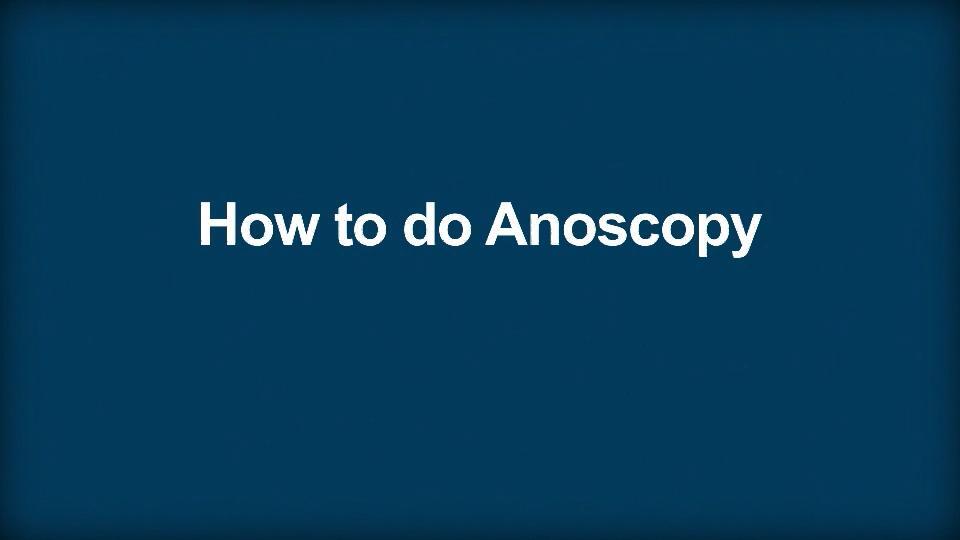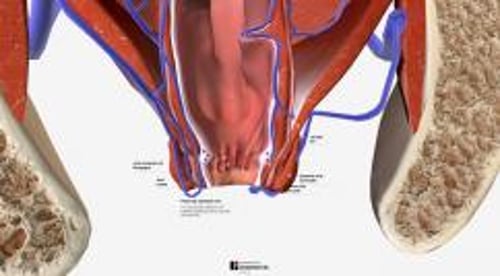Topic Resources
(See also Anoscopy and Sigmoidoscopy.)
Indications for Anoscopy
To evaluate anorectal symptoms such as anal pain, discharge, protrusions, or pruritus
To evaluate bright red bleeding
To evaluate complicated hemorrhoids and provide certain types of hemorrhoid therapy (1)
For evaluation or therapy of squamous cell lesions of the anal canal (2)
To evaluate any suspected disorder of the anal canal
Indications references
1. Tarasconi A, Perrone G, Davies J, et al. Anorectal emergencies: WSES-AAST guidelines. World J Emerg Surg. 2021 Sep 16;16(1):48. doi: 10.1186/s13017-021-00384-x
2. Stewart DB, Gaertner WB, Glasgow SC, Herzig DO, Feingold D, Steele SR; Prepared on Behalf of the Clinical Practice Guidelines Committee of the American Society of Colon and Rectal Surgeons. The American Society of Colon and Rectal Surgeons Clinical Practice Guidelines for Anal Squamous Cell Cancers (Revised 2018). Dis Colon Rectum. 2018 Jul;61(7):755-774. doi: 10.1097/DCR.0000000000001114
Contraindications to Anoscopy
Absolute contraindications
Shock
Acute myocardial infarction
Peritonitis
Acute bowel perforation
Fulminant colitis
Absence of an anus due to surgery or a congenital condition
Relative contraindications
Cardiac arrhythmias or recent myocardial ischemia (if procedure cannot be postponed, patients will need cardiac monitoring)
Recent anal surgery
Anal strictures
Poor patient cooperation
Severe anal pain (procedure would need to be performed under anesthesia)
Suspected perirectal abscess (based on symptoms)
Complications of Anoscopy
Complications are rare, but the following can occur:
Perianal abrasion or mild tear
Minor bleeding
Equipment for Anoscopy
Gloves
7-cm adult (typically 19-mm diameter) anoscope (slotted or nonslotted); smaller sizes (8- to 14-mm diameter) for children or those with pain or anal stenosis
Light source (sometimes built into disposable anoscope)
Lubricating jelly (and topical anesthetic jelly if patient has severe anal pain)
Cotton swabs
Fecal occult blood test (if needed)
Culture tube and swab (if needed)
Biopsy forceps (if needed)
The nonslotted anoscope is used for 360° visualization, whereas the slotted anoscope is for visualization of only one portion at a time. The slotted anoscope should not be rotated; it is better for visualization and treatment of hemorrhoids.
Additional Considerations for Anoscopy
No bowel prep is needed for anoscopy.
The American Heart Association no longer recommends endocarditis prophylaxis for patients having routine gastrointestinal endoscopy (1).
Additional considerations reference
1. Baddour LM, Wilson WR, Bayer AS, et al; American Heart Association Committee on Rheumatic Fever, Endocarditis, and Kawasaki Disease of the Council on Cardiovascular Disease in the Young, Council on Clinical Cardiology, Council on Cardiovascular Surgery and Anesthesia, and Stroke Council. Infective Endocarditis in Adults: Diagnosis, Antimicrobial Therapy, and Management of Complications: A Scientific Statement for Healthcare Professionals From the American Heart Association. Circulation. 2015 Oct 13;132(15):1435-86. doi: 10.1161/CIR.0000000000000296. Epub 2015 Sep 15. Erratum in: Circulation. 2015 Oct 27;132(17):e215. doi: 10.1161/CIR.0000000000000332. Erratum in: Circulation. 2016 Aug 23;134(8):e113. doi: 10.1161/CIR.0000000000000427. Erratum in: Circulation. 2018 Jul 31;138(5):e78-e79. doi: 10.1161/CIR.0000000000000594
Positioning for Anoscopy
Place the patient in the left lateral decubitus position with knees flexed toward the chest.
Other positions, such as lithotomy position, are acceptable if needed.
Relevant Anatomy for Anoscopy
The anal canal is about 3 to 5 cm long and connects the distal rectum to the outside.
The lower part of the anal canal, below the dentate line, is lined by stratified squamous epithelium. This epithelium has dense innervation by somatic nerve fibers and is quite sensitive.
Step-by-Step Description of Anoscopy
Purpose: To visualize the internal portions of the anal sphincter and the distal rectum (1):
Pull the buttocks apart and visually inspect the external area.
Insert a lubricated gloved finger to do a routine digital rectal exam (use topical anesthetic jelly if patient has severe anal pain and does not have an allergy).
If using a topical anesthetic jelly, wait 1 to 2 minutes to give the anesthetic time to take effect.
If there is no gross blood, test any stool obtained for fecal occult blood, if indicated, and change glove on this hand.
Lubricate the anoscope and the central guide plug.
Slowly insert the anoscope, with the central guide plug in place.
After the anoscope is completely inserted, remove the central guide plug (keep the plug available because it may be needed again).
If using a nonslotted anoscope, slowly rotate it while withdrawing it and inspect the entire mucosa for masses, lesions, hemorrhoids, or fissures. Any fecal material or blood can be removed with a cotton swab to aid visualization.
Culture any abnormal discharge.
If indicated, biopsy any suspect mass but only if above the dentate line.
If indicated, hemorrhoid therapy can be performed in the office.
Step-by-step description reference
1. London S, Hoilat GJ, Tichauer MB. Anoscopy. 2023 Aug 28. In: StatPearls [Internet]. Treasure Island (FL): StatPearls Publishing; 2025 Jan–. PMID: 29083587.
Aftercare for Anoscopy
Although no particular aftercare is needed, tell patients to contact their physician immediately if there is significant bleeding or pain after the procedure.
Warnings and Common Errors for Anoscopy
Do not biopsy a hemorrhoid or any vascular tissue.
Do not rotate a slotted anoscope because doing so can pinch tissue.
Do not reinsert the guide plug while the anoscope is inside the patient because doing so can pinch or tear tissue. Remove the anoscope completely, reinsert the guide plug, and then reinsert the anoscope.
Tips and Tricks of Anoscopy
Inspection of the external perianal area may be adequate to diagnose causes of severe anal pain such as a fissure, thrombosed external hemorrhoid, or some abscesses; in these cases, digital exam and anoscopy may not be indicated.
If prolapse is suspected, a Valsalva maneuver may reveal prolapsing hemorrhoids or mucosa.
Asking the patient to bear down while inserting a finger for digital exam or the anoscope may make the insertion easier.
Keep one finger pressed on the guide plug (usually your thumb) to prevent it from falling out during insertion until it is ready for removal.




